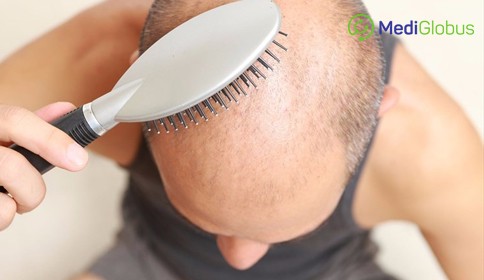People who try to defeat baldness have many questions. MediGlobus specialists gave detailed answers to the most popular of them, which will help patients to navigate better through methods of combating hair loss.
WHAT IS THE DIFFERENCE BETWEEN BALDNESS PATTERN IN WOMEN AND MEN? IS HAIR TRANSPLANTATION PERFORMED FOR WOMEN?

The difference is that women who face this problem lose hair evenly over the entire area of the hairline, while men discover bald patches in different areas. So baldness can occur in both men and women.
Women also approach for hair follicle transplantation – the process of preparing for surgery, the procedure of transplantation and the postoperative period does not have any unique differences based on gender.
Although active growth of hair in the transplanted area can be somewhat slower in women, which is connected with the hormonal activity.
WHAT IF THERE ARE ALREADY BALD PATCHES ON THE HEAD?
When baldness becomes apparent to both the person himself and his surrounding, there are several noticeable behaviors:
- Change of hair style or shaving head ideally (not suitable for women);
- Application of cosmetic procedures and vitamin supplements;
- Use of powders creating the effect of thick hair (result is due to the microfibers included in the composition of the source);
- Sticking of special linings, which are the hair attached to a transparent adhesive tape;
- Radical and maximally effective way, which gives a permanent effect is a hair transplant surgery.
WHICH METHOD OF HAIR TRANSPLANT IS BETTER AND SAFE? ARE THERE ANY SCARS LEFT?
In this modern age and with the development of medicine, three methods of hair transplantation are actively used:
- FUT (follicular unit transplantation) – the technique of the operation involves cutting out the area of the skin with the hair, which is later divided into grafts. After the procedure, the patient has a scar approximately 1.5 cm wide and 20 cm long at the occiput.
- FUE (follicular unit extraction) is a minimally invasive method for the removal and implantation of hair follicles. In this method, the doctor extract minor areas of the skin with hair follicles using a specialized tool – then grafts are separated from it. After FUE, there is no scarring and the recovery period is much fast.
- HFE (hand follicle extraction) is the newest non-surgical version of hair transplantation. The process of extraction and implantation of hair is carried out with the help of microneedles. After the specialist’s work, there are no traces and scars, the site, which was transplanted, looks as natural as possible. The healing process of the zones that were involved in the operation takes only 14 days.
Leading specialists use the FUE method most often, because it is combined and mixes the best features of other methods of hair transplantation. Since the HFE technique is still quite new, it is only gaining popularity, although some doctors have already switched to it completely.
IS IT POSSIBLE TO DO HAIR TRANSPLANTATION TO THE BEARD IF HAIR ON THE FACE IS NOT GROWING?
Yes, in case of hair transplant to the face, donor hair is often taken from areas of the chest or on the hands, follicles on the face may not participate in the operation. For hair transplant to face, the HFE method is predominantly used as it makes it possible to accurately conduct transplants to the beard, mustache, eyebrows or eyelashes.
DO YOU NEED TO CARE FOR THE TRANSPLANTED HAIR?
Transplanted hair requires special care only in the beginning after surgery – they need to be gently cleansed using special means. You should strictly follow the doctor’s instructions on the lack of physical activity and the cancellation of certain drugs during the recovery phase – this gives better environment so that the maximum number of transplanted grafts will survive. After the recovery process you can provide a usual care to your entire hair.
WHEN CAN I SLEEP AND WASH MY HEAD NORMALLY?
On the day of surgery, patient is recommended to take anesthetic drugs so that the discomfort after the procedure does not interfere with sleep. Further use of similar preparations is on personalized basis. As a rule, painful sensations do not last long.
As for the washing of the head – it is strictly forbidden to wet and wash the head for the first 3 days after the transplant, as this can cause injuries to the transplants. After this period, the head can be washed carefully, without sudden movements and a strong pressure of water.
DO I NEED A LONG SICK LEAVE? WHEN CAN I RETURN TO WORK? HOW MUCH TIME WILL I BE IN THE HOSPITAL?
No, a long sick leave is not required – patient can return to work few days after the procedure. In clinic it takes about 8-10 hours, this is an average hair transplant operation duration.
Patient is sent home on the same day, driving is not recommended since sedatives are active for some time.
ARE THE TRANSPLANTED HAIR NOTICEABLE TO SURROUNDING?
If the transplant was performed by a qualified doctor, most people will not be able to see that the person has the transplanted hair – even with a more traumatic FUT operation, the scar is hidden by growing hair in neighboring areas. However, it is worthwhile to understand that the effect after transplantation does not come immediately: the grafts take time to take root and began to grow in 4 to 8 months.
IN WHAT CASES CLINIC CAN REFUSE TAKING PATIENT? WHAT AGE LIMITATIONS EXIST FOR HAIR TRANSPLANTATION?
As with any intervention in the human body, there are contraindications to the procedure, which are grounds for refusing to conduct the procedure. These include:
- Decompensated diabetes mellitus;
- Malignant neoplasms;
- Disorders in the blood clotting system;
- Acute infections;
- Chronic infections in the acute stage;
- Period of pregnancy and lactation;
- Depleted hair in the donor area or insufficient hair for transplant.
There is no age limit for hair transplant surgery, but young patients should not think about transplantation before 18-20 years.
HOW TO UNDERSTAND, ONE OPERATION IS ENOUGH AND WILL THE TRANSPLANTED HAIR NOT FALL AGAIN?
It is very difficult to assess the potential of the donor zone on its own. To do this, you should contact a specialist who will accurately determine how many grafts will be transplanted and whether a repeat procedure is required. The hair that was transplanted is not prone to fallout and as a result of the operation all the accustomed grafts will function normally.
DOES THE DONOR ZONE WILL LOOK BAD AFTER THE TRANSPLANT, HOW THE QUANTITY OF HAIR REDUCES IN THERE? WHAT ARE THE RISKS OF HAIR TRANSPLANTATION?
After the operation, the donor zone continues to look good – the removal of grafts is carried out evenly, in order to preserve the naturalness of the density of the hairline. With all the prescriptions of the attending physician, the likelihood of developing risks is very small and usually the operation and the recovery period do not cause concern.
DO YOU NEED TO TAKE MEDICINES SUPPORTING THE EFFECT OF HAIR TRANSPLANTATION? I HEAR THAT THE HAIRS IN THE TRANSFER ZONE MAY BE LOST IN 2 MONTHS. MEANING THERE IS NO GUARANTEE THAT THE OPERATION WILL SUCCEED?

Doctors recommend taking individually selected vitamins, stimulating hair growth for 6-8 months after the operation. Medicines that would “hold” the transplanted follicles are not required.
Hair does fall out in the transplant zone 20 days after the operation. This is due to the unusual experience given to grafts during transplantation.
However, this process does not threaten the final result, because the hair falls out itself, and the bulb remains active. Regarding the survival of transplanted hair, clinics give guarantee of 90-98% – depending on the method of transplantation.
CAN YOU BECOME A DONOR OF HAIR FOR ANOTHER PERSON?
When transplanting, only the patient’s own hair is used. Firstly, no one can give a guarantee on the behavior of transplanted hair from someone else – transplanted grafts can simply not take root. Secondly, the operation of hair transplantation is performed to achieve most aesthetic and natural appearance of the patient – this can only be achieved through the similarity of the structure and shade of transplants with a total mass of hair.





